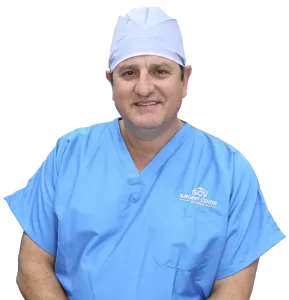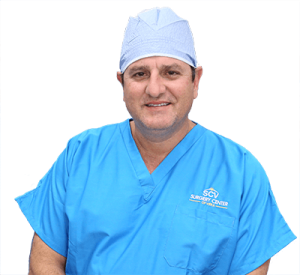
Inflammation of the facet joints in the spine or the sacroiliac joints between the spine and the pelvis is known as spinal arthritis. Wear and tear, autoimmune diseases, infections, and other ailments could all have a role. The areas where ligaments and tendons join the bones of the spine can occasionally also be affected by inflammation. No matter where it occurs, arthritis in the back or neck can be excruciatingly painful and frequently progresses to chronic disease.
If you or a loved one is experiencing any of the following symptoms outlined in this article, it’s time to get a FREE Consultation and MRI Review with Deuk Spine Institute. We will help relieve your pain and get you back to living your life without limitations!
Depending on the type of arthritis you have, there are many causes of arthritis in the neck and back. Other than regular wear and tear and autoimmune triggers, the precise cause is often yet unknown. Some types of spinal arthritis have genetic components associated with them, suggesting that it may be inherited. Additional risk elements for spinal arthritis include:
More than 100 different forms of arthritis exist, and the majority of them can harm the neck or back. Even though all forms of arthritis cause inflammation, they are divided into inflammatory and noninflammatory (degenerative) forms according to where they originate.
Spinal osteoarthritis
The most prevalent type of spine arthritis is osteoarthritis, often known as non-inflammatory or degenerative arthritis. It often develops over time and usually affects the lower back.
Inflammation and pain are caused by the gradual breakdown of the cartilage between the joints. Since the discomfort is the result of mechanical damage, bending or twisting your back usually makes it more apparent. Degenerative arthritis of the spine might occur as a result of prior back traumas.
The facet joints between the vertebrae are typically affected by osteoarthritis of the spine. It is sometimes referred to as facet disease, facet joint condition, and facet joint arthritis.
Facet joint arthritis may occasionally be exacerbated by the degeneration of the spinal discs (degenerative disc disease). The facet joints are under increasing pressure as the discs between the vertebrae deteriorate. This causes greater friction, which in turn causes more cartilage injury.
Cervical spondylosis is the term used to describe this disorder when these degenerative changes take place in the neck. Many patients with neck arthritis show no symptoms at all, and pain isn’t usually a symptom.
Spinal rheumatoid arthritis
An autoimmune condition, or one in which the immune system attacks itself, is rheumatoid arthritis (RA). The synovium, which lines the joints, is attacked. Rheumatoid arthritis can damage the spine, particularly the cervical region, despite the fact that it is more common in other joints (neck). Spinal rheumatoid arthritis is inflammatory arthritis since it is not brought on by normal wear and tear. Even when these joints are not in use, it may nevertheless result in back discomfort (as well as pain in other joints). More often than not, it affects women more than men.
Spondyloarthritis
A category of inflammatory illnesses known as spondyloarthritis affects both the joints and the places where the ligaments and tendons attach to the bones (entheses). Despite having an inflammatory origin, spondyloarthritis is not the same as rheumatoid arthritis. Spondyloarthritis comes in a variety of forms, some of which are more prevalent in the spine than others:
Axial spondyloarthritis, according to a separate categorization, is a specific type of arthritis that affects the spine and/or sacroiliac joints. Peripheral spondyloarthritis is the medical term for this condition if additional joints and tendons are affected. Both forms are frequently present at various stages of the development of spondyloarthritis in many people.
Spinal arthritis symptoms can vary from person to person. In general, they might consist of:
Even those with advanced spinal arthritis do not always experience back pain, despite the fact that it is a prevalent sign. However, some people may already be in pain before arthritis is seen on an X-ray. Eye inflammation (iritis or uveitis), which can result in pain, wet eyes, and blurred vision, can happen in some kinds of spondyloarthritis.
The nerve roots leaving the spine are being compressed by bone spurs that developed on the facet joints. Bone spurs, which are growths on the margins of the bones, can be brought on by spinal arthritis. Bone spurs, in particular, cause the facet joints of the spine to enlarge. Facet joint hypertrophy is the medical term for this problem. Even though bone spurs don’t necessarily cause harm, they can make it harder for the spinal cord and nerves to escape the spine. Two unpleasant circumstances could result from this:
Additional issues brought on by ankylosing spondylitis, which is the calcification of the ligaments between the vertebrae, include:
To confirm spinal arthritis, your doctor may employ some or all of the diagnostic techniques listed below:
Your doctor may administer an injection to the troublesome joint to help identify it, and then monitor the area to see if the pain subsides.
Numerous variables affect how spinal arthritis is treated. Your age, level of discomfort, kind and degree of arthritis, and personal health objectives may be among them. Due to the irreversible nature of the joint destruction brought on by arthritis, pain management and damage control are typically the main goals of treatment. There are several nonsurgical options for treating spine arthritis:
In the case of spinal arthritis, surgery might be suggested if previous treatments are insufficient to reduce discomfort. A few examples of the surgery’s objectives are:
These operations can be carried out either openly or with a minimally invasive technique. Every approach has advantages and disadvantages. Prior to the procedure, the surgeon will go over and discuss the choices.
The Deuk Spine Institute encourages and welcomes you to contact us today regarding any questions or concerns you may have regarding your current situation.
If you or someone you love is experiencing any of the preceding symptoms outlined, it is imperative to get a FREE Consultation and MRI Review with the Deuk Spine Institute. We can help relieve your pain and get you back to living your life without limitations!

